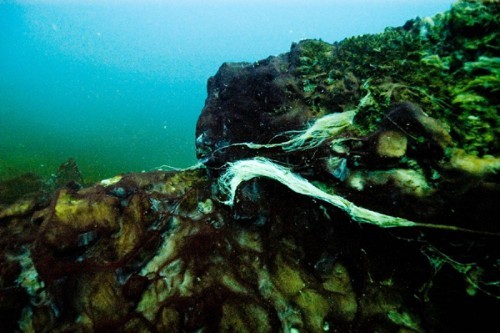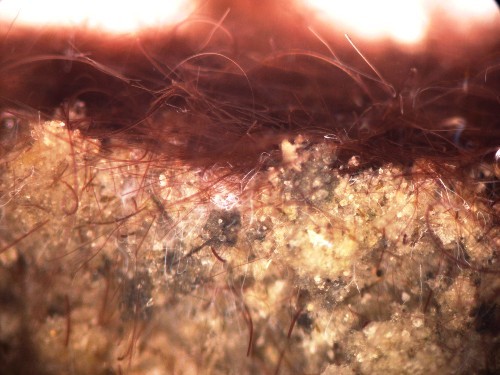
There is a crater in the ground. Through a screen of murky green water, thick, rolling mats of bright purple or stark white can be seen in that hole, decorating the area like living statement rugs.
This isn’t the basis for some new science fiction movie; it’s a sinkhole in Lake Huron. And while it isn’t actually an alien environment, it is being used to study what life and habitats could be like on other planets.
The term for this type of study is analog, where a similar, more accessible environment is studied in place of a less accessible one. The environments of other planets are a perfect example where this kind of study is useful.
Finding the needle in the data haystack
“The reason we know there was water on Mars is we know and understood how to look for minerals that could only form if there had been water on Mars,” said Kennda Lynch, staff scientist at the Universities Space Research Association/Lunar and Planetary Institute. “There’s validation from our analog work almost every day in planetary research.”
Lynch is an astrobiologist and while her work isn’t with Lake Huron’s sinkholes, she studies hypersaline earth environments as analogs for other planetary environments. That means environments with salt concentrations in the 15 to 20 percent range, like the Great Salt Lake in Utah. For reference, the ocean is roughly 3 percent salt.
How planetary analog research works is robotic researchers are sent into the solar system, satellites that stay in the atmospheres or landers that go to the surface and gather data, and then scientists try to find somewhere on earth where the data is similar to study in its place, Lynch said.
“Analogs aren’t perfect,” she said. “But it helps point us in the right direction so we can try and understand these other planets better. Instead of being a needle in a haystack, we have a pointed direction of where this needle could be.”
Lake Huron’s underwater cyanobacteria

On board NOAA’s research vessel Laurentian in Lake Huron, Bopi Biddanda is preparing a remotely operated vehicle. (Courtesy of Robert B. Annis Water Resources Institute’s Biddanda Lab)
That’s where Lake Huron’s sinkholes come in.
These sinkholes first came to Bopi Biddanda’s attention in 2003. Biddanda, an aquatic microbial ecologist, is a professor of water resources with Grand Valley State University on the west side of Michigan. At the time, he had been part of an archeology group looking at shipwrecks in the Thunder Bay National Marine Sanctuary. They were using an ROV—remotely operated vehicle—measuring temperature, conductivity and depth to map wrecks. Near the lake bottom, the conductivity readings spiked.
On the bottom of lakes Michigan, Huron, Ontario and Erie are layers of limestone bedrock, and sometimes that limestone dissolves and forms sinkholes through which groundwater can enter the lakes. These holes can be more than 300 feet across and up to 60 feet deep.
Unlike the lake water surrounding the sinkholes, the water in them is salty and high in sulfur with no oxygen.
It got Biddanda thinking that if water with different chemistry from the lakes exists in the sinkholes in Lake Huron, maybe there’s different life as well. And indeed, they found purple and white mats of cyanobacteria in the sinkholes, kickstarting years of research into them.
The cyanobacteria in question are not the kind that can be found on the surface of Lake Erie during harmful algal bloom season, but they are from the same family.
“In Lake Erie, they’re colonial, they make blobs,” Biddanda said. “These are filamenters. They make long chains. As far as we know, the ones at the bottom of Lake Huron are not toxic. That’s our impression so far.”
What has been found so far?
The cyanobacteria can move millimeters in minutes and move both horizontally and vertically.
The mats come in two colors. Purple if they’re closer to shore and photosynthetic, white if they’re in deeper water out of reach of sunlight and thus rely on chemosynthesis and sulfur-based chemicals in the water instead. The chemosynthesis and one form of the photosynthesis do not produce oxygen. The photosynthetic cyanobacteria can switch between oxygen-producing and non-oxygen-producing photosynthesis depending on what’s around them.

Remotely operated vehicle image of purple ridge mountains in the Middle Island Sinkhole in Lake Huron. Late in the summer, mats rise into small hills and ridges less than a foot high, buoyed up by gasses produced in the organic matter-rich sediments trapped below. Some of these raised “hills’ tear and float away in the surface of the lake – possibly serving as a dispersal mechanism. (Courtesy of Rob Paddock, University of Wisconsin via Bopi Biddanda)
In the shallower sinkholes, with the purple photosynthetic cyanobacteria, a lot of organic carbon sediments have been found. The sediment is up to 20 percent carbon, while usually Great Lakes sediments tend to be around 5 percent carbon.
“They know how to bury carbon. That’s a very important finding. They climb over anything that shadows them so anything that falls on them gets buried under them where it gets preserved,” Biddanda said.
And when you bury carbon, you get oxygen.
It is speculated that microbes like these were earth’s early inhabitants, turning a previously sulfur-rich environment into the oxygenated environment we know and can live in today.

Microscopic cross section of the mat-sediment complex collected from the bottom of Middle Island Sinkhole, showing a layer of mostly purple and some white microbial filaments, overlying whitish carbonate crystals and darker organic carbon-rich sediment below. (Courtesy of Robert B. Annis Water Resources Institute’s Biddanda Lab)
“We like to think these organisms were historically found everywhere,” Biddanda said. “And now they’re hiding in these refuges where there’s no oxygen and high sulfur.”
Cyanobacteria like the ones in the Lake Huron sinkholes are currently found in only one other place, the ice-covered lakes of Antarctica.
A look at early earth or a look into other planets
There are many uses for Biddanda’s research into these sinkhole ecosystems. A big driver of him is looking for more evidence that the sinkhole ecosystems can serve as windows to early life on earth.
“I think many of us in some way want to know about why we’re here and where do we come from. Why do we live on a planet that is habitable for humans and animals?” said Gregory Dick, an associate professor with the University of Michigan’s Department of Earth and Environmental Sciences.
He has been collaborating with Biddanda on researching the sinkholes since 2009.
“One of our research goals is to understand why this planet and the life on it change together over time, and these living mats help us reconstruct the story of how the modern world came to be,” Dick said.
And once we understand more about earth’s history, that knowledge can be applied outward.
“Could you find an ecosystem like this in the subsurface of Enceladus and Europa, because we know they have subsurface oceans?” Universities Space Research Association/Lunar and Planetary Institute’s Lynch said. “Would this be the ecosystem we see? Who knows? But could we also see it on Mars, in some of the deep paleolakes we know they had there?”
A paleolake is a lake that existed in the past but has disappeared or shrunk over time.
“I think the potential there is really great,” she said, “so I think it’s great to study ecosystems like this.”
Featured Image: As groundwater containing high-sulfur and no-oxygen flows down a rocky ledge from the sinkhole, it nourishes unique sinkhole-specific purple photosynthetic and white chemosynthetic mats. Above, in lake water, the standard photosynthetic green algae flourish. (Courtesy of Tane Casserley, National Marine Sanctuaries via Bopi Biddanda)
Curious about the sinkholes? Great Lakes Now’s Ric Mixter recorded his dive into one of them. Take a look HERE.




